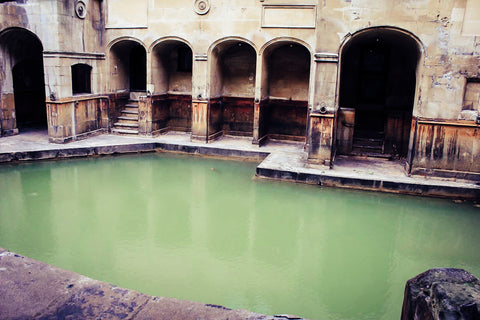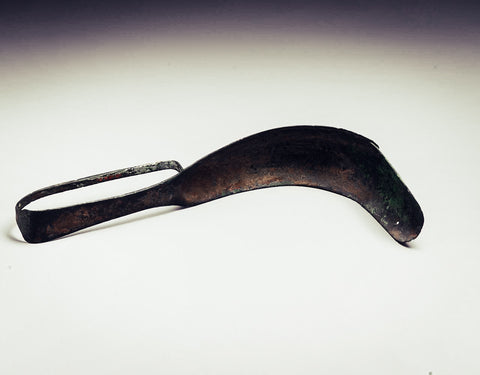Our pure goat milk soap was our very first creation for Beekman 1802. Unfortunately, we were not soap-savants when we started out. Creating our first bars of soap required a lot of trying, failing and studying to understand the ins and outs of producing high-quality bar soap.
One thing we learned in our studies is that there’s a dirty side to the history of soap. From secret recipes to government-mandated monopolies, bar soap started from humble beginnings and soon became a worldwide luxury. The history of soap is long and winding, so let’s jump right in.
So how old is soap?
Imagine that you live in ancient times. The rising sun wakes you up and you get to your daily work. After a long day of hunting, gathering and communicating with your neighbors, it’s time for a shower. You take out your block of clay and scrub, scrub, scrub. Don’t like clay? Well, you could use some pumice, maybe a little sand if you’re feeling frisky.
This may seem confusing to you, but during the B.C. years, this was how you got clean. If you bothered to clean yourself at all.
One of the most surprising facts about the history of bar soap is that, for a very long time, soap wasn’t for bodies. One of the first recorded uses of a soap-like substance was in 2800 B.C. Babylonians used a mixture of ash and animal fat to clean things around their dwellings. It was mostly used on textiles and tools. Eventually, as the recipes for these soap substances were passed along tribes and trade routes, it began to take on a bigger role in cleaning primitive field equipment and used during medical procedures.
Ancient societies experimented with a variety of materials to create soap that could keep their tools clean. Generally, the ingredients were some type of animal fat, a variety of oil and salts. Many followed the lead of the Babylonians and mixed ashes leftover from cooking fires with leftover animal fat. Ancient Egyptians poured alkaline salts into an animal fat and vegetable oil mixture to get their cleaning done. Phoenicians used goat tallow, while ancient Germans used tallow and ash in a potent combination that not only cleaned but would also dye materials.

What we know as soap today took a very long time to get into our bathing rituals. Back in the day, bathing was more of a luxury than a necessity. Ancient Egyptians and Romans are some of the first to record using baths, but bathes were only used on special occasions or medicinally. The people who would bathe the most usually had to so because they needed to keep a wound clean.
The ancient Greeks’ bathing rituals usually involved scrubbing the body with clay or pumice, then anointing oneself with oils. Then they would take out a metal instrument called a strigil and scape off the oil and dirt.

Who made bar soap?
Bar soap as we know it today didn’t start popping up until the seventh century. According to historical documents, soapmakers were starting businesses in Spain, France, and Italy. England followed in the 12th century, and soon bathing with a bar of soap became a trend. This led to a surge in use of bar soaps across Europe and a surge in pricing.
During the Restoration era in England, the English monarchy introduced a soap tax, officially making bar soap a luxury item. King Charles I had previously granted the Society of Soapmakers of Westminster total control over large-scale soapmaking in England, so this new tax raised soap prices even more. Strict rules were placed on where, how and when soap could be manufactured.
These restrictive practices trickled down from factories to independent artisans. Since it was difficult to make soap anyways, small groups of artisans banded together and formed exclusive groups. They kept their soapmaking ways a secret, not only to create a monopoly on artisanal soap but also to reap the benefits of the high market prices.
But soon, the soap conglomerate fell. The Society of Soapmakers of Westminster lost their monopoly on production, the soap tax was repealed in 1853 and chemists had created easier ways to mass-produce bar soap. The reign of luxury soap was over by the 1900s. With soap production on the rise and prices falling, bar soap finally made its way into modern hygiene.
Bar soap today
Soap is so common today that the word soap is used to describe all different types of cleansing products. Most items that we call soap aren’t soap at all, they are actually detergents. Detergents, also known as surfactants, are created by synthetic compounds. Detergents initially were created out of necessity during times where traditional soap ingredients were scarce, like during World War I.
In its most basic form, soap is a mix of a fat and an alkaline. To be legally called soap, it needs to contain a variation on these two ingredients. Other than these two ingredients, an endless amount of materials can be added.

There are some benefits to using bar soap versus non-soap bars and detergents. The reasons ancient societies used a mixture of oils, fats, and salts to clean important items are still true today. This combination of ingredients is very efficient at getting things clean. Studies have shown that bar soap does a better job removing dirt, oil, makeup and other impurities from the skin. Bar soaps are also created with simpler ingredients and can be easier to use for people with sensitive skin and allergies.
But there are some downsides. The ingredients in bar soap are great at removing oil, but sometimes they can be too great at removing oil, resulting in dryness. That’s why at Beekman 1802, we chose ingredients in our soap that are natural and less likely to irritate your skin, starting with our goat’s milk and finishing with ingredients like oatmeal and sweet grass.
So, when choosing a bar soap, make sure it contains gentle ingredients and when in doubt, patch test!
Modern bar soaps may be more elegant than their ancient counterparts, but it’s important to remember the humble beginnings of this wonderful product.
